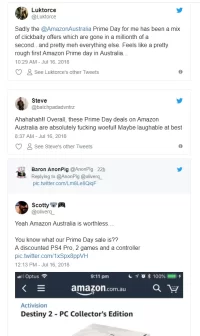biophase
Platinum Contributor
FASTLANE INSIDER
EPIC CONTRIBUTOR
LEGACY MEMBER
MEMBER
Read Rat-Race Escape!
Read Fastlane!
Read Unscripted!
Hahah yeah you're telling me. Even when you order on Amazon if it's non prime it generally takes > 5 days.
Alright, I'll start looking into it then and see if I can find some relevant products.
What's your thoughts in regards to what I said about piggybacking on niches/products that are popular on the US Amazon? Do you think this is a wise move or do you think it would be better to do some research and figure out what sort of products people in AU are buying?
Speaking of research, for Amazon is it the same as any other eCommerce business? Look into Facebook / Google numbers, look at similar products and reviews, etc... Or is there additional variables to consider when looking into Amazon selling?
It’s kinda of hard to say if something in the USA will sell the same as in Australia.
You know your market better than me.
With that said, I’m sure people in Australia buy normal everyday things like supplements, socks, towels, etc... in the USA.
But something like mountain bikes, hunting clothing or aftermarket car parts I’d have no idea how popular they would be.
I probably wouldn’t stick to a niche and just go for something big at this point.
Dislike ads? Become a Fastlane member:
Subscribe today and surround yourself with winners and millionaire mentors, not those broke friends who only want to drink beer and play video games. :-)
Membership Required: Upgrade to Expose Nearly 1,000,000 Posts
Ready to Unleash the Millionaire Entrepreneur in You?
Become a member of the Fastlane Forum, the private community founded by best-selling author and multi-millionaire entrepreneur MJ DeMarco. Since 2007, MJ DeMarco has poured his heart and soul into the Fastlane Forum, helping entrepreneurs reclaim their time, win their financial freedom, and live their best life.
With more than 40,000 posts packed with insights, strategies, and advice, you’re not just a member—you’re stepping into MJ’s inner-circle, a place where you’ll never be left alone.
Become a member and gain immediate access to...
- Active Community: Ever join a community only to find it DEAD? Not at Fastlane! As you can see from our home page, life-changing content is posted dozens of times daily.
- Exclusive Insights: Direct access to MJ DeMarco’s daily contributions and wisdom.
- Powerful Networking Opportunities: Connect with a diverse group of successful entrepreneurs who can offer mentorship, collaboration, and opportunities.
- Proven Strategies: Learn from the best in the business, with actionable advice and strategies that can accelerate your success.
"You are the average of the five people you surround yourself with the most..."
Who are you surrounding yourself with? Surround yourself with millionaire success. Join Fastlane today!
Join Today


